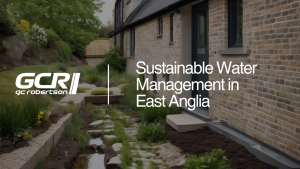
As climate change accelerates, regions like East Anglia face significant challenges in water management. With increasing instances of flooding and rising economic costs, civil engineers are increasing efforts to incorporate sustainable drainage systems (SuDS) and innovative approaches to mitigate the impacts of extreme weather. Drawing inspiration from best practices seen in major cities, including London, the integration of advanced drainage solutions is essential for East Anglia’s future resilience.
East Anglia, known for its extensive coastline and low-lying topography, is particularly susceptible to flooding and water runoff issues. As rainfall becomes more unpredictable and intense, the existing infrastructure struggles to manage excess water effectively. Implementing SuDS can play a pivotal role in addressing these concerns.

What does Rainfall and Flooding in East Anglia look like in the near future?
25% Increase in Extreme Rainfall Events by 2050: Recent studies predict that East Anglia could experience a 25% increase in extreme rainfall events by mid-century. This emphasises the urgency of enhancing drainage infrastructure to prevent widespread surface flooding.
£1.5 Billion Potential Annual Flood Damages: Projections indicate that, without significant drainage improvements, annual flood damage costs in East Anglia could approach £1.5 billion by 2050. This figure underscores the economic rationale for investing in sustainable water management solutions.
70% Reduction in Runoff Possible Through SuDS: Implementing SuDS in urban and suburban areas has shown the potential to reduce surface water runoff by up to 70%, significantly easing the burden on traditional drainage networks and mitigating flood risks.
Over 30% of Households at Risk by 2040: By 2040, it’s estimated that over 30% of East Anglian homes could be at risk of surface water flooding, highlighting the need for pre-emptive measures like permeable pavements, rain gardens, and green roofs.
The Role of SuDS in Sustainable Engineering
SuDS are designed to mimic natural water drainage processes, absorbing and channeling water in a controlled manner. By integrating these systems, not only can the region reduce immediate flooding risks, but it can also contribute to groundwater recharge and urban cooling. Examples of effective solutions include retention basins, vegetated swales, and bio-retention areas, which can transform how communities interact with and manage water.
East Anglia has the opportunity to lead by example in the UK by embracing these sustainable engineering practices, thereby securing a safer, more resilient future for its residents and economy.
GC Robertson are Consulting Structural & Civil Engineers with five decades of engineering experience. We provide engineering solutions across residential, commercial, heritage and industrial projects.
